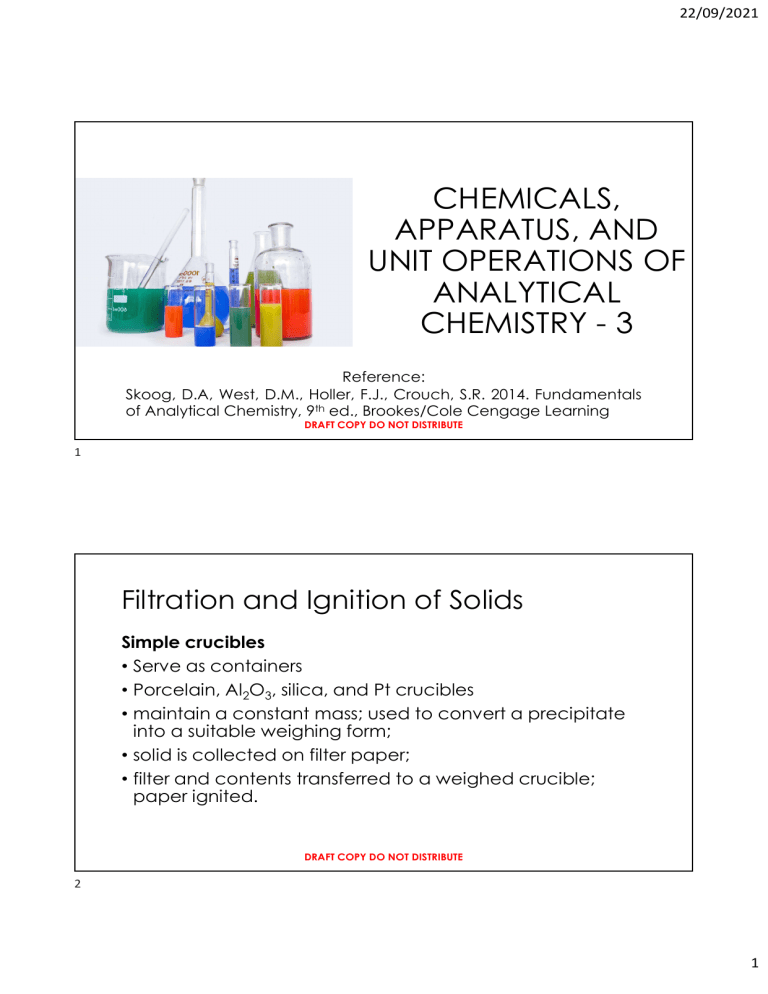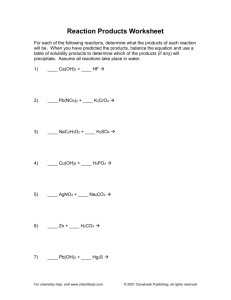
22/09/2021 CHEMICALS, APPARATUS, AND UNIT OPERATIONS OF ANALYTICAL CHEMISTRY - 3 Reference: Skoog, D.A, West, D.M., Holler, F.J., Crouch, S.R. 2014. Fundamentals of Analytical Chemistry, 9th ed., Brookes/Cole Cengage Learning DRAFT COPY DO NOT DISTRIBUTE 1 Filtration and Ignition of Solids Simple crucibles • Serve as containers • Porcelain, Al2O3, silica, and Pt crucibles • maintain a constant mass; used to convert a precipitate into a suitable weighing form; • solid is collected on filter paper; • filter and contents transferred to a weighed crucible; paper ignited. DRAFT COPY DO NOT DISTRIBUTE 2 1 22/09/2021 Filtration and Ignition of Solids Simple crucibles • Ni, Fe, Ag, and Au crucibles are as containers for hightemp. fusion of samples that are not soluble in aqueous reagents Filtering Crucibles • Serve not only as containers but also as filters • Vacuum is used to hasten filtration • Tight seal between crucible and filtering flask is accomplished with several types of rubber adaptors DRAFT COPY DO NOT DISTRIBUTE 3 Filtration and Ignition of Solids • Collection of a precipitate with a filtering crucible is frequently less time consuming than with paper. Fig. 1. Adaptors for filtering crucibles. (Source: Skoog et al. 2014, p. 28_ DRAFT COPY DO NOT DISTRIBUTE 4 2 22/09/2021 Filtration and Ignition of Solids • Sintered glass or fritted glass crucibles • Marked fine (f), medium (m) and coarse (c) • Made of quartz • Temp limit is ~200oC; same for crucibles w/ unglazed porcelain or Al2O3 frits • Now costly as quartz DRAFT COPY DO NOT DISTRIBUTE 5 Filtration and Ignition of Solids • Gooch Crucibles • Has perforated bottom that supports a fibrous mat • Asbestos was used before as matting fiber • Glass mats have replaced asbestos, can tolerate temp >500oC, less hygroscopic than asbestos. DRAFT COPY DO NOT DISTRIBUTE 6 3 22/09/2021 Filtration and Ignition of Solids DRAFT COPY DO NOT DISTRIBUTE 7 Filter Paper • An important filtering medium • Ashless filter paper – from cellulose fibers that have been treated with HCl and HF (to remove metallic impurities and silica) and then neutralized with NH3 Note: residual NH3 may affect the analysis result for Nitrogen by the Kjeldahl method. • All filter papers tend to pick up moisture from the atmosphere • It is necessary to destroy the paper by ignition if the precipitate that is collected on it is to be weighed DRAFT COPY DO NOT DISTRIBUTE 8 4 22/09/2021 Filter Paper • Typically 9- or 11-cm circles of ashless paper leave a residue that weighs less than 0.1 mg. • Coarse-porosity ashless paper is most effective for filtering gelatinous precipitates such as hydrous iron (III) oxide Note: Problem of clogging the pores can be minimized by mixing a dispersion of ashless filter paper with the precipitate prior to filtration. DRAFT COPY DO NOT DISTRIBUTE 9 Source: Skoog et al, 2014,p. 29 DRAFT COPY DO NOT DISTRIBUTE 10 5 22/09/2021 Filtration and Ignition of Solids • Heating Equipment 1. Drying oven – capable of maintaining a constant temperature to within 1oC • 110oC is satisfactory drying temperature • Efficiency greatly increased by forced circulation of air; passage of pre-dried air through an oven under partial vacuum represents additional improvement DRAFT COPY DO NOT DISTRIBUTE 11 Filtration and Ignition of Solids 2. Microwave Lab ovens • Greatly shorten drying cycles, e.g., slurry samples • Shorten heating time (12-16 hrs in conventional oven requires only 5-6 minutes in the microwave oven) 3. Heat Lamp • Dry precipitate collected on ashless paper and to char a paper as well DRAFT COPY DO NOT DISTRIBUTE 12 6 22/09/2021 Filtration and Ignition of Solids 4. Burners • Sources of intense heat • Types: Meker provides the highest temperature, followed by Tirrill and Bunsen burners • Heavy Duty Electric (Muffle) Furnace • Capable of maintaining controlled temps. Of 1100oC or higher • Long-handled tongs and heat-resistant gloves are needed DRAFT COPY DO NOT DISTRIBUTE 13 Filtering and Igniting Precipitates Preparation of Crucibles • Crucible – used to convert a precipitate to a form suitable for weighing; must maintain a constant mass throughout drying or ignition • Crucible is cleaned thoroughly and subjected to the same regimen of heating and cooling as that required for the precipitate. • Heating-, cooling- and weighing-process is repeated until constant mass has been achieved, i.e., until consecutive weighings differ by ±0.3 mg DRAFT COPY DO NOT DISTRIBUTE 14 7 22/09/2021 Filtering and Igniting Precipitates Filtering and Washing Precipitates • Decantation – as much as supernatant liquid as possible is passed through the filter while the precipitated solid is kept essentially undisturbed in the beaker (precipitating vessel) where it was formed Speed the overall filtration rate by delaying the time at which the pores of the filter become clogged with precipitate When flow ceases, the drop of liquid at the end of the pouring spout is collected with the stirring rod and returned to the beaker DRAFT COPY DO NOT DISTRIBUTE 15 Filtering and Igniting Precipitates Wash liquid is next added to the beaker and thoroughly mixed with the precipitate Solid is allowed to settle, and then this liquid is also decanted through the filter. Most washing should be carried out before the bulk of the solid is transferred; results This technique results in a more thoroughly washed precipitate and a more rapid filtration. DRAFT COPY DO NOT DISTRIBUTE 16 8 22/09/2021 Filtering and Igniting Precipitates The bulk of the precipitate is moved from beaker to filter by directed streams of wash liquid where a stirring rod provides direction for the flow of material to the filtering medium Last traces of precipitate that cling to the inside of the beaker are dislodged with a rubber policeman, a small section of rubber tubing that has been crimped on one end and fitted onto the end of a stirring rod Last traces of the gelatinous precipitates (e.g., hydrous oxides) can be wiped with ashless filter and ignited together with the precipitate. DRAFT COPY DO NOT DISTRIBUTE 17 Filtering and Igniting Precipitates Filters are never filled to more than ¾ of capacity to prevent the possible loss of precipitate through creeping (spreading of precipitate over a wetted surface against the force of gravity) Addition of a small amount of nonionic detergent (e.g., Triton X-100) to the supernatant liquid or wash liquid can help minimize creeping. Do not permit a gelatinous precipitate to dry until it has been washed completely dry; further addition of wash liquid (to the dry precipitate) simply pass through these cracks and accomplish little or no washing. DRAFT COPY DO NOT DISTRIBUTE 18 9 22/09/2021 Filtering and Igniting Precipitates a) Washing by decantation b) Transferring the precipitate DRAFT COPY DO NOT DISTRIBUTE 19 Filtering and Igniting Precipitates Preparation of Filter Paper a) Filter paper is folded exactly in half and crease it firmly b) Fold the paper a second time DRAFT COPY DO NOT DISTRIBUTE 20 10 22/09/2021 Filtering and Igniting Precipitates c. Tear off one of the corners on a line parallel to the second fold. d. Open the untorn half of the folded paper to form a cone. DRAFT COPY DO NOT DISTRIBUTE 21 Filtering and Igniting Precipitates e. Seat the cone firmly into the funnel f. Moisten the paper slightly and gently pat the paper into place. DRAFT COPY DO NOT DISTRIBUTE 22 11 22/09/2021 Filtering and Igniting Precipitates Transferring Paper and Ppt to Crucible • Filter and contents must be transferred from the funnel to a crucible that has been brought to constant mass • Flatten the cone along its upper edge; corners are flattened inward; the edge is then folded over; finally, paper and contents are cased into the crucible, w/ bulk of ppt is neat the bottom DRAFT COPY DO NOT DISTRIBUTE 23 Filtering and Igniting Precipitates Transferring a filter paper and precipitate from a funnel to a crucible a. Pull the triple-thick portion of the cone to the opposite side of the funnel. b. Remove the filter cone from the funnel, and flatten the come along its upper edge DRAFT COPY DO NOT DISTRIBUTE 24 12 22/09/2021 Filtering and Igniting Precipitates c. Fold the corners inward. d. Fold the top edge of the cone toward the tip and enclose the precipitate in the paper e. Gently ease the folded paper and its contents into the crucible. DRAFT COPY DO NOT DISTRIBUTE 25 Filtering and Igniting Precipitates Ashing Filter Papers • Using heat lamp Crucible is placed on a clean, nonreactive surface (e.g., such as wire screen covered with Al foil) Lamp is then positioned about 1cm above the rim of the crucible and turned on The process is accelerated by the addition of not more than a drop of concentrated NH4NO3 solution DRAFT COPY DO NOT DISTRIBUTE 26 13 22/09/2021 Filtering and Igniting Precipitates Burner is used Produces much higher temperatures than heat lamp Mechanical loss of precipitate may occur if moisture is expelled too rapidly in the initial stages of heating or paper burns into flames Partial reduction of some precipitates can occur through reaction with the hot carbon of the charring paper Reduction can be minimized by positioning the crucible in a tilted position to allow for the easy access of air with the cover be kept handy to extinguish any flame. DRAFT COPY DO NOT DISTRIBUTE 27 Filtering and Igniting Precipitates Ashing Filter Papers • Heating should begin with a small flame • Char the paper using moderate heat, with the crucible slightly tilted, covering partially the mouth of the crucible with the cover. • The amount of smoke given off indicates the intensity of heating that can be tolerated. • A significant increase in smoke indicates that the paper is about to flash, and that heating should be temporarily discontinued. DRAFT COPY DO NOT DISTRIBUTE 28 14 22/09/2021 Filtering and Igniting Precipitates Incorrect DRAFT COPY DO NOT DISTRIBUTE correct 29 Filtering and Igniting Precipitates • Any flame should be immediately extinguished with a crucible cover. • The cover may be discolored from the condensation of carbonaceous products. • These products must be ultimately be removed from the cover by ignition to confirm the absence of entrained particles of precipitate. • When no further smoking can be detected, heating is increased to eliminate the residual carbon. DRAFT COPY DO NOT DISTRIBUTE 30 15 22/09/2021 Filtering and Igniting Precipitates DRAFT COPY DO NOT DISTRIBUTE 31 Filtering and Igniting Precipitates • Strong heating can then be undertaken. • This sequence precedes the final ignition of a precipitate in a muffle furnace DRAFT COPY DO NOT DISTRIBUTE 32 16 22/09/2021 Filtering and Igniting Ppts DRAFT COPY DO NOT DISTRIBUTE 33 Filtering and Igniting Precipitates • Using Filtering Crucibles • A vacuum filtration train is used when a filtering crucible can be used instead of paper. • The trap isolates the filter flask from the source of vacuum DRAFT COPY DO NOT DISTRIBUTE 34 17 22/09/2021 Rules for manipulating heated objects 1. Practice unfamiliar manipulations before putting them to use. 2. Never place a heated object on the benchtop. Instead, place it on a wire gauze or a heat-resistant ceramic plate. 3. Allow a crucible that has been subjected to the full flame of a burner or a muffle furnace to cool momentarily before transferring it to the desiccator. 4. Keep the tongs and forceps used to handle heated objects scrupulously clean. Do not allow the tips to touch the benchtop. DRAFT COPY DO NOT DISTRIBUTE 35 Assignment 1. Learn how to use Chem Draw application. DRAFT COPY DO NOT DISTRIBUTE 36 18

